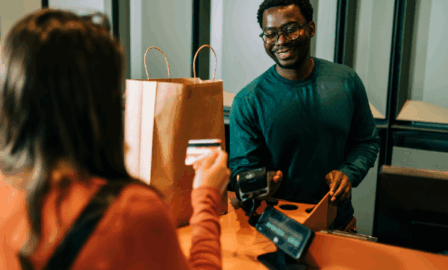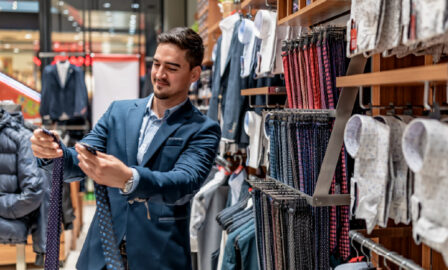5 Key Takeaways from Shoptalk Fall 2024
Last week, industry experts gathered in Chicago, Illinois for Shoptalk Fall 2024, a leading retail conference. Over the course of three days, attendees explored the latest innovations and challenges facing retailers today. The event covered a wide range of topics, including the importance of in-person experiences, the rise of livestream shopping, the evolution of loyalty programs, as well as the need for efficient change management and sustainability initiatives. We summarized our top takeaways from Shoptalk Fall 2024 below.
Takeaways from Shoptalk Fall 2024
1. The Importance of “IRL” Experiences
The phrase “in real life,” or “IRL,” was arguably the most used phrase of the week. While much of today’s focus is on digital interactions, we’re continuing to see the value that IRL experiences bring – especially across generations. According to Nielsen, Gen Z, despite being largely digitally driven, actually over-indexes on in-store dollars spent compared to other generations, further highlighting the growing importance on in-person engagement.
As brands focus more on IRL experiences, they are, in turn, feeding into the customer demand for authenticity and community. Glossier is a prime example of a brand that thrives in both digital and physical spaces as a community-based brand that actually listens to its customers. The brand celebrates beauty IRL, with pop up events in major cities like NYC and community channels on platforms like Slack and Reddit. By targeting every generation – from Millennials to Gen Z and now Gen Alpha – Glossier understands that its value will be in its ability to create community, which is a strategy that will continue to pay off in the long-run.
“[We’re on] year 10 of building a 100-year brand.” – Kyle Leahy, CEO at Glossier, Inc.
2. The Importance of Livestream Shopping as Part of a Unified Commerce Strategy
Livestream shopping is rapidly becoming a cornerstone of unified commerce, blending physical and digital retail experiences in a way that resonates best with consumers. This approach demonstrates the power of live selling, which requires a different and unique skillset as compared to traditional eCommerce selling; live selling is more like a friend telling you about a product that they like and recommend, making it more engaging and authentic.
Shein US, for example, has been a leader in this space, hosting roughly four livestream shows a week to showcase its vast product selection. Fabletics has also capitalized on this trend, understanding that consumers prefer video content above all else. In fact, their strategy, which prioritizes video over static photos, has nearly doubled conversion rates.
“People want to watch videos.” – Adam Goldenberg, Co-Founder and CEO at Fabletics
As retailers continue to build a unified commerce strategy, they should explore livestream shopping as an option that will help them stand out amongst competition.
3. The Importance of Loyalty Programs and Differentiated App Experiences
Another key topic that emerged from Shoptalk revolved around loyalty programs and app experiences. In a session led by Crate & Barrel, Alicia Waters highlighted how the brand has implemented augmented reality (AR) capabilities to offer a new, virtual store experience. This not only meets customers in a new way, but it also piques customer curiosity. In fact, their global flagship in NYC has an impressive 70% engagement rate.
While these digital tools are important, there needs to be a healthy balance between digital innovation and human interaction. Crate & Barrel is also focusing on positioning itself as a “whole home retailer,” finding customers on social and guiding them through the entire purchasing funnel. A major aspect of this strategy includes enhancing their app and prioritizing customer service. The brand hopes to create a seamless experience and build brand loyalty with this customer centric approach, meeting their customers at their various stages of life – taking their customer from wedding registry to baby registry.
Several other companies also highlighted the continued importances of loyalty programs and member-exclusive app experiences. These remain a significant driver of engagement, often resulting in better conversion rates.
4. The Importance of Change Management in Organizational Transformation
Change management is vital in organizational transformation. Christina Hennington from Target highlighted the “practicality of rolling it [technology] out” in a way that makes sense for the organization and in a way that allows humanity and technology to come together. After all, successful transformation lies at this intersection and requires a balance between short- and long-term goals. Hennington explained, “It is hard to do both, but you have to. Have clarity on where you’re going and what makes you who you are.”
J. Crew CIO Danielle Schmelkin also offered a compelling example of this. As the brand works to prioritize unified commerce and connectedness across channels, they remember to look inward and think: what does this mean for our staff? It means adapting to new workflows and balancing the use of 3rd party solutions with those built in-house. Schmelkin continued, “It’s about communication. Technology does what you tell it to do.”
Enacting an organizational change management (OCM) strategy is pivotal and allows brands to remain at the forefront of innovation, rather than simply execute on request.
5. The Importance of Reverse Logistics and Sustainability Efforts
We know all too well that consumers are increasingly prioritizing sustainability, making reverse logistics – focused on handling returns, recycling, etc. – a critical component of the modern supply chain. In the session titled “Tools, Tactics, and Structures that Enable Supply Chain Resiliency,” Abercrombie & Fitch’s Larry Grischow, alongside Ace Hardware’s Rick DiMaio, covered the importance of investing in modern systems to ensure that your supply chain is always in position to win. In fact, a session poll revealed that audience members and industry experts noted overcoming legacy systems to enable growth as their top supply chain challenge. What does this mean? There is a unique opportunity here for retailers to leverage reverse logistics and advancements in technology. Abercrombie, for instance, is leveraging AI to optimize forecast accuracy and inform demand planning.
As it relates to sustainability, Irene Quarshie from Target highlighted the sustainability problem in apparel and how it can’t just be a few companies that build out these processes while others neglect it. More specifically, Quarshie explained that, “82 pounds of textile waste is generated per person each year in the US.” With this in mind, Target is continuing to invest in understanding products’ end of life and the resale market. Specific initiatives include Target’s “Denim Take Back Event” and Target Forward.
Looking Ahead
This year’s conference provided an invaluable opportunity to connect and engage with industry leaders on critical topics impacting the retail landscape. As businesses continue to face challenges, it’s clear that customer-centricity, innovation, change management, and a commitment to sustainability will be key drivers of success.
To continue discussing key takeaways from Shoptalk Fall 2024 or to explore other emerging trends in the industry, contact our team of experts today.
Subscribe to Clarkston's Insights




